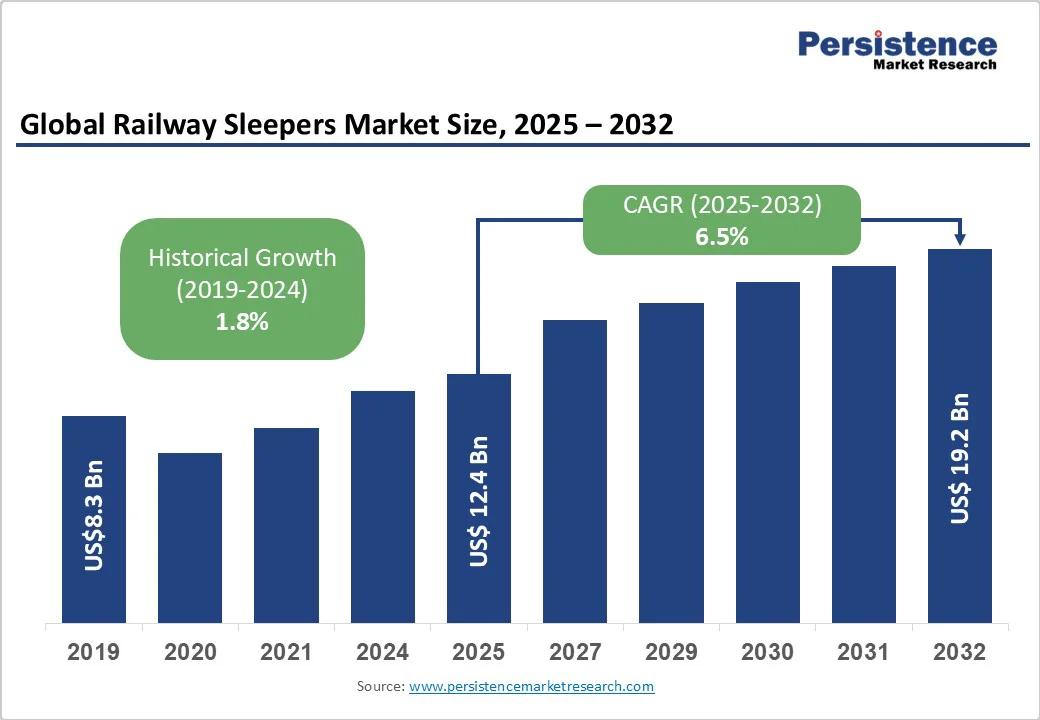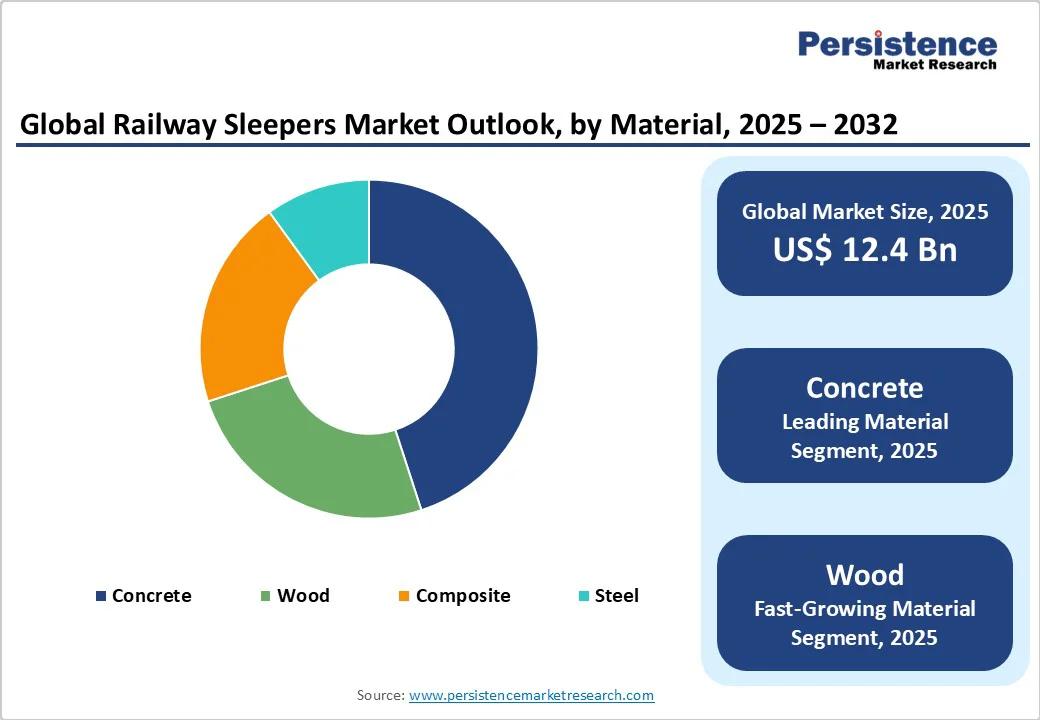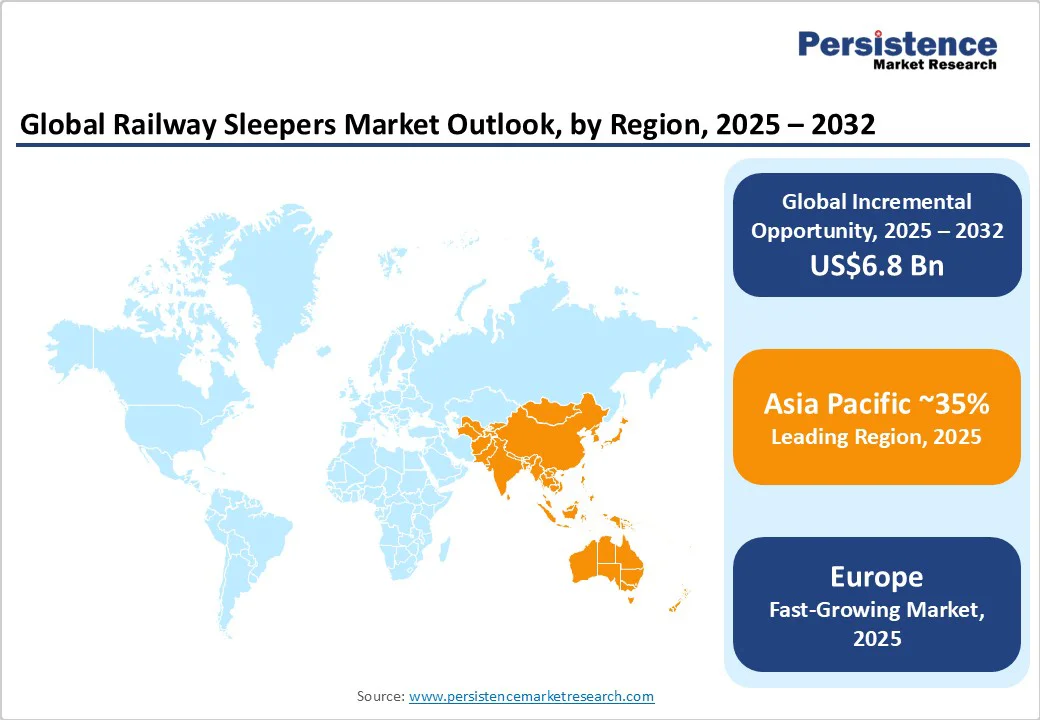ID: PMRREP30617| 177 Pages | 1 Oct 2025 | Format: PDF, Excel, PPT* | Automotive & Transportation

The global railway sleepers market size is likely to value US$ 12.4 Bn in 2025 and is projected to reach US$ 19.2 Bn by 2032 growing at a CAGR of 6.5% during the forecast period from 2025 to 2032.
The market is propelled by infrastructure development, technological innovations, and increased investments in railway networks globally. Governments worldwide are investing in railway modernization and high-speed rail projects.
| Key Insights | Details |
|---|---|
| Railway Sleepers Market Size (2025E) | US$ 12.4 Bn |
| Projected Market Value (2032F) | US$ 19.2 Bn |
| Global Market Growth Rate (CAGR 2025 to 2032) | 6.5% |
| Historical Market Growth Rate (CAGR 2019 to 2023) | 1.8% |

The railway sleeper market is experiencing a significant surge in demand, mainly propelled by rising infrastructure projects worldwide. Governments and private entities are investing heavily in developing and modernizing railway networks to meet the increasing demands of urbanization, population growth, and the need for sustainable transportation solutions. The expansion encompasses constructing new rail lines as well as rehabilitating and upgrading existing infrastructure, leading to a substantial requirement for railway sleepers.
In various emerging economies, rapid urbanization is driving the expansion of metro and light rail systems to prevent traffic congestion and provide efficient public transportation options. Additionally, investments in high-speed rail projects are gaining momentum as countries seek to enhance connectivity between key cities and regions.
Infrastructure developments necessitate the installation of vast quantities of railway sleepers to support the tracks and ensure the safe and smooth operation of trains. In developed countries with aging railway infrastructure, there is a pressing need to rehabilitate and replace deteriorating sleepers. This is being done to maintain safety standards and accommodate modern train technologies.
Innovations in the railway sleeper industry are driving a shift toward sustainability and enhanced performance. Introduction of unique materials like composites has revolutionized the industry, offering superior durability and performance compared to traditional materials. Coupled with ongoing advancements in sleeper designs and manufacturing processes, these developments have resulted in enhanced structural integrity and extended lifespans.
Leading companies are extending their presence globally through strategic partnerships and acquisitions to meet the rising demand worldwide. Additionally, integrating sensors and monitoring systems into sleepers is revolutionizing maintenance practices by enabling real-time monitoring, thereby enhancing the management of rail infrastructure.
The industry is also experiencing a transformative phase characterized by sustainable solutions and technological developments. It is mainly driven by the imperative to uphold safety standards and meet the demands of modern rail infrastructure. For instance, in 2024, L.B. Foster introduced smart sleeper technology equipped with sensors to monitor track conditions in real-time. It aims to detect deviations in track gauge and load distribution anomalies promptly, facilitating proactive maintenance and enhancing track stability.
Investments in research and development activities aimed at reducing the density of sleepers in railway tracks have significantly impacted demand for sleepers. Expansion of railway infrastructure and construction of railway tracks entail substantial costs. To mitigate these expenses and accelerate track expansion, manufacturers and governments are investing in research to decrease the density of sleepers.
Demand for traditional railway sleepers has been affected, as the shift in track design and construction methodologies has reduced the number of sleepers required per unit length of track. It is gradually diminishing the demand for new sleeper installations.
Manufacturers are actively exploring innovative solutions and technologies to optimize track layouts and enhance track stability while reducing the number of sleepers used. Demand for railway sleepers has been impacted, as fewer sleepers are needed to support the expanding railway infrastructure.
The railway sleepers market has recently encountered a significant upswing due to increasing global rail megaprojects under construction. High government spending on transportation infrastructure, rising emphasis on sustainability, and the need for operational resilience have created a substantial demand for high-quality, durable railway sleepers.
As new projects aim to connect urban populations while minimizing carbon emissions efficiently, demand for cutting-edge and reliable railway sleepers has never been higher. Governments and project developers are focusing on long-term operational efficiency and sustainability, leading to a preference for high-quality sleepers that can withstand the demands of high-speed and heavy-load rail traffic. This prioritization of durability and performance standards offers an avenue for manufacturers to innovate and enhance their offerings.
The current boom in global rail megaprojects presents a golden opportunity for the railway sleepers market. By embracing innovation, adhering to high-quality standards, and focusing on sustainability, manufacturers can solidify their positions and thrive in this dynamic period.
As the monumental projects progress, demand for unique railway sleepers will continue to rise. It will likely create new opportunities for industry players to extend their reach and enhance their market share. For instance, in 2024, in response to India's extensive railway expansion plans, The Indian Hume Pipe Co. scaled up its manufacturing capabilities. It is now focusing on producing high-strength concrete sleepers to meet the specific requirements of new and upgraded rail networks in the country.
Based on material, the global market is divided into wood, concrete, composite, and steel. Out of these, the concrete material dominates the market with 50% share in 2025. Concrete sleepers are exceptionally durable and can withstand high loads, making them ideal for both high-speed rail and heavy freight lines. The robustness of concrete sleepers reduces maintenance requirements and enhances track longevity compared to wood and composite alternatives.
Although initial installation costs for concrete sleepers can be higher than wood, their low maintenance needs and long service life make them a cost-effective choice over time. It is particularly evident in regions investing in long-term infrastructure.
Concrete sleepers are highly resistant to environmental conditions, including moisture and pests, unlike wood, which is susceptible to decay and insect damage. This makes concrete ideal for use in various climates and contributes to longer track life.
Based on track type, the market is segregated into tangents, turnouts, bridges, and tunnels. Among these, the tangent segment dominates the global market with 68% share in 2025. Tangent tracks are the straight sections of railway tracks where the alignment is linear and uninterrupted. Sleepers used on these tracks are typically designed to provide uniform support and maintain the precise gauge of the track.
The sleepers must ensure stability and proper alignment over long, straight distances, accommodating the dynamic loads exerted by high-speed and heavy trains. Materials like concrete and composite are often preferred for tangent tracks due to their durability and ability to maintain structural integrity under constant stress.
Tangent tracks also experience less stress and wear compared to turnouts and curves, which require high maintenance due to the forces exerted during train passage. As a result, tangent tracks benefit from longer-lasting sleepers, making them suitable for standard concrete sleepers that need less frequent replacement.

Asia Pacific dominates the global market, driven primarily by rapid infrastructure expansion, especially in countries like China and India. The region is marked by significant government investments aimed at modernizing and expanding railway networks, including high-speed rail lines.
China has made extensive strides in developing its rail system, with key funding allocated to broaden high-speed rail connectivity. It helped in improving both passenger and freight transport capabilities. Similarly, India is investing in its railway infrastructure, focusing on modernization and capacity enhancement.
The railway sleepers market in China has a bright future, with growth prospects in the development of high-tech and high-speed railway infrastructure. China also possesses unique railway systems and is set to invest US$ 154 Bn in railway track expansion across the country. The development of high-speed railway systems and the rising usage of composite railway sleepers for railway tracks are two emerging trends that will have a direct impact on China.
Asia Pacific's dominance is further supported by the rising demand for sustainable and durable sleeper materials to brace long-lasting infrastructure in these high-growth economies. The commitment to infrastructure development and modernization positions the region as the largest and fastest growing in the global market.
In North America, government-led infrastructure initiatives are significantly boosting the railway sleeper’s market. The U.S. is investing heavily in railway modernization to enhance both freight and passenger transportation, creating substantial demand for new sleepers in rail expansion and refurbishment projects. Continuous innovation in sleeper materials and manufacturing processes has improved durability, safety, and cost efficiency, encouraging railway operators to adopt advanced products with longer service life.
Sustainability has emerged as a priority, with North American rail companies increasingly shifting toward eco-friendly sleeper options such as recycled composite and sustainably sourced timber. These efforts align with the region’s broader push for greener infrastructure.
Additionally, growing economic activity and urbanization are driving higher freight and commuter rail traffic across the U.S., Canada, and Mexico. To meet this rising demand, operators are expanding rail networks and upgrading existing lines, further fueling market growth for railway sleepers in the region.

The global railway sleepers market is competitive, featuring key players such as Vossloh AG, L.B. Foster Company, PCM RAILONE AG, and The Indian Hume Pipe Co. Ltd. These companies strive to capture a high market share through innovations in sustainability and durability.
Leading companies are also broadening their manufacturing capabilities to meet the surging demand driven by global infrastructure projects. Vossloh and L.B. Foster lead in terms of the development of composite and smart sleepers with integrated monitoring technology, addressing the need for real-time maintenance insights.
PCM RAILONE has pioneered sulfur concrete sleepers, emphasizing eco-friendly materials. The Indian Hume Pipe Co. is scaling its operations to support India's extensive rail expansion. These firms are focused on enhancing sleeper longevity, sustainability, and operational efficiency to remain competitive in this evolving market.
The Railway Sleepers market is estimated to be valued at US$ 12.4 Bn in 2025.
The key demand driver for the Railway Sleepers market is the expansion and modernization of railway infrastructure to support increasing freight and passenger traffic.
In 2025, the Asia Pacific region will dominate the market with an exceeding 35% revenue share in the global Railway Sleepers market.
Among the Track Type, tangents Equipment holds the highest preference, capturing beyond 68% of the market revenue share in 2025, surpassing other parts.
The key players in the Railway Sleepers market are Vossloh AG, RailWorks Corporation, Patil Group and Kirchdorfer Group.
| Report Attribute | Details |
|---|---|
| Historical Data/Actuals | 2019 - 2024 |
| Forecast Period | 2025 - 2032 |
| Market Analysis Units | Value: US$ Bn, Volume: Units |
| Geographical Coverage |
|
| Segmental Coverage |
|
| Competitive Analysis |
|
| Report Highlights |
|
By Material
By Track Type
By Line Type
By Application
By Region
Delivery Timelines
For more information on this report and its delivery timelines please get in touch with our sales team.
About Author